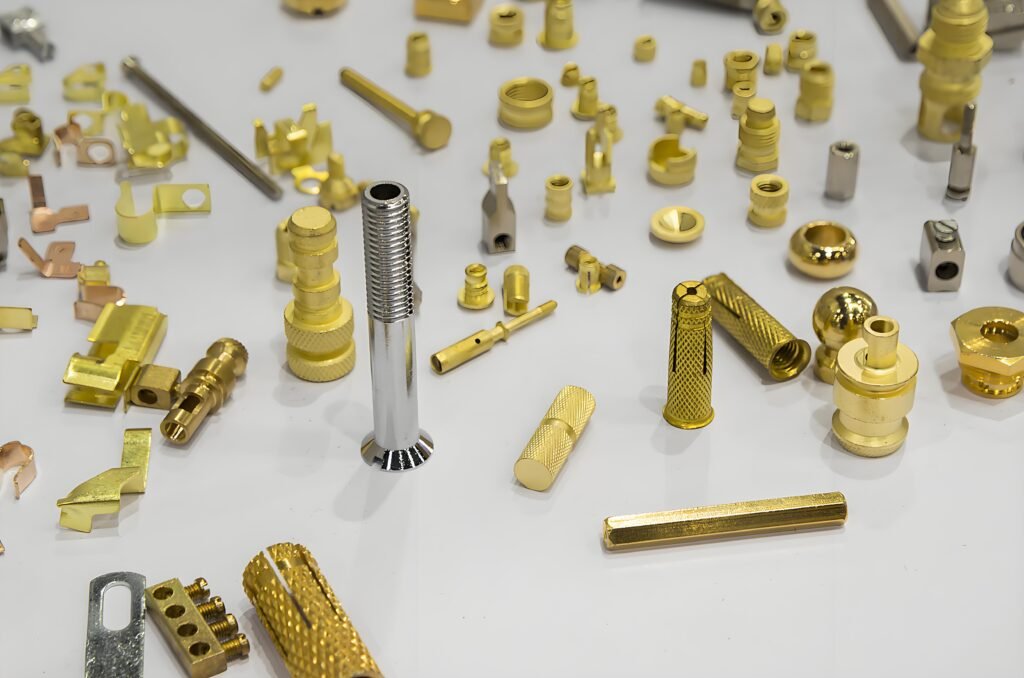Did you know that nearly 90% of the world’s goods are either directly or indirectly affected by metal finishing processes like electroplating? This staggering statistic highlights the significance of electroplating in modern manufacturing.
Electroplating is a versatile metal finishing that enhances the properties of various materials by coating them with a thin layer of metal. This is achieved through electrodeposition, where a controlled electrolysis transfers the desired metal coating from an anode to a cathode.
By combining the strength, electrical conductivity, and corrosion resistance of certain metals with different materials, electroplating transforms ordinary components into durable, conductive, and aesthetically appealing products. As you explore this comprehensive guide, you’ll learn about the science behind electroplating, its benefits, and its applications across multiple industries.
What Is Electroplating?
Electroplating is a process that involves depositing a thin layer of metal onto a substrate using an electric current. This technique is crucial for enhancing the properties of the base metal, such as its corrosion resistance, wear resistance, and aesthetic appeal.
Fundamentals of Electroplating
At its core, electroplating relies on the principle of electrodeposition, where metal ions in a solution are reduced onto a cathode (the substrate) when an electric current is passed through the solution. This process not only changes the surface properties of the substrate but also can be used to repair worn or damaged parts by rebuilding their surfaces.
Today, electroplating is a sophisticated process with precise controls and environmentally conscious practices, far evolved from its rudimentary beginnings. The industry continues to innovate, improving the efficiency and sustainability of electroplating processes.

The Electroplating Process
Understanding the electroplating process is crucial for achieving high-quality coatings. The process involves several critical components and steps that must be carefully controlled to ensure optimal results.
Components Required for Electroplating
The electroplating process requires several key components, including a power supply, an anode, a cathode (the workpiece to be plated), and an electrolytic bath. The electrolytic bath contains metal ions that will be deposited onto the cathode. You must carefully select and maintain these components to ensure the quality of the electroplating.
How Electrodeposition Works
Electrodeposition is the heart of the electroplating process. When you immerse the workpiece (cathode) in the electrolytic bath and pass an electric current through it, metal ions from the bath are reduced and deposited onto the cathode surface. This process builds up a layer of the desired metal on the workpiece. The quality of the deposit depends on factors such as current density, bath temperature, and the chemical composition of the bath.
Step-by-Step Electroplating Process
The electroplating process begins with thorough surface preparation of the workpiece, including cleaning, degreasing, and activation. Next, the workpiece is connected to the negative terminal of the power supply and immersed in the plating bath alongside the anode. As the current is applied, metal ions deposit onto the cathode, forming a uniform coating. Throughout the process, parameters such as current density, temperature, and pH are carefully monitored. After achieving the desired coating thickness, the plated part undergoes post-treatment processes like rinsing and passivation to enhance its properties.
By carefully controlling the electroplating process, you can achieve high-quality coatings that meet your specific needs. Factors such as bath conditions, part placement, and electrical current parameters all play a crucial role in determining the quality of the final product.
Types of Electroplating Techniques
You can choose from multiple electroplating techniques, depending on the specific needs of your project. The choice of technique depends on the desired properties of the final product, the type of material being plated, and the equipment available.
Barrel Plating
Barrel plating is a method used for electroplating small parts in bulk. This technique involves placing the parts in a barrel-shaped container that is then submerged in an electroplating bath. As the barrel rotates, the parts tumble and are evenly coated with the plating metal. Barrel plating is efficient for high-volume production and is often used for small components like fasteners and jewelry findings.
Rack Electroplating
Rack electroplating is a technique where the parts to be plated are mounted on a rack or frame, which is then immersed in the electroplating bath. This method allows for precise control over the plating process and is suitable for larger or more complex parts that cannot be effectively plated in a barrel. Rack electroplating is commonly used for items like automotive trim and decorative fixtures.
Electroless Plating
Electroless plating, also known as autocatalytic plating, is a process that deposits metal without the use of electrical current. Instead, it relies on a chemical reaction to reduce metal ions onto the substrate. This technique provides a uniform coating and is particularly useful for plating non-conductive materials or parts with complex geometries. Electroless nickel plating is a popular variant, known for its corrosion resistance and wear properties.
Common Metals Used in Electroplating
Various metals are used in electroplating to enhance the characteristics of the base material. The choice of metal depends on the desired properties of the final product, such as corrosion resistance, wear resistance, or aesthetic appeal.
Base Metals
Base metals are commonly used in electroplating due to their availability and cost-effectiveness. They provide a range of properties that can enhance the base material.
Copper, Nickel, and Zinc
Copper is often used for its excellent electrical conductivity and corrosion resistance. Nickel is valued for its hardness and corrosion resistance, making it a popular choice for industrial applications. Zinc is widely used for its protective properties, particularly in preventing iron from rusting.
Iron, Tin, and Chromium
Iron is sometimes used in electroplating for its magnetic properties. Tin is used for its corrosion resistance and is often applied to steel to prevent rust. Chromium is known for its shiny appearance and is used to achieve a decorative finish while also providing corrosion resistance.
Precious Metals
Precious metals are used in electroplating for their unique properties and aesthetic value. They are often applied in thinner layers due to their high cost.
Gold, Silver, and Platinum
Gold is used for its high conductivity and resistance to corrosion. Silver is valued for its electrical conductivity and is often used in electronics. Platinum is known for its catalytic properties and is used in various industrial applications.
Palladium and Rhodium
Palladium is used as a more affordable alternative to platinum, offering similar catalytic properties. Rhodium is known for its reflective surface and is often used to plate white gold and other jewelry.
Metal Alloys in Electroplating
Metal alloys are used to combine the beneficial properties of multiple metals. For example, zinc-nickel alloys offer superior corrosion resistance compared to pure zinc. Brass, an alloy of copper and zinc, is used for its attractive appearance and durability.
By using metal alloys, you can achieve specific properties that are not available with single metals. The composition of these alloys can be precisely controlled during the electroplating process.
Benefits and Limitations of Electroplating
Understanding the benefits and limitations of electroplating is vital for harnessing its potential in various industries. As you explore electroplating, you’ll discover that it offers a range of advantages that make it a valuable process for enhancing the properties of materials.
Key Advantages
Electroplating provides several key benefits, including improved corrosion and wear resistance, enhanced appearance, and increased electrical conductivity.
Corrosion and Wear Resistance
One of the primary advantages of electroplating is its ability to protect base metals from corrosion and wear. By depositing a layer of a more resistant material, electroplating can significantly extend the lifespan of components.
Improved Appearance and Aesthetics
Electroplating can also enhance the appearance of a material, providing a decorative finish that is both visually appealing and durable. This is particularly valuable in industries where aesthetics play a crucial role.
Enhanced Electrical Conductivity
Certain electroplating processes can improve the electrical conductivity of a material, making it suitable for applications where high conductivity is required.
Limitations and Challenges
While electroplating offers numerous benefits, it also presents several challenges and limitations, including environmental concerns, process complexity, and material compatibility issues.
Environmental Concerns
The electroplating process involves the use of chemicals and heavy metals, which can pose environmental risks if not managed properly. Ensuring that electroplating operations are environmentally friendly is crucial.
Process Complexity
Electroplating is a complex process that requires careful control of several parameters to achieve the desired outcome. This complexity can make it challenging to achieve consistent results.
Material Compatibility Issues
Not all materials are compatible with electroplating. For instance, non-conductive substrates like plastic or wood must be made conductive before electroplating can occur. Ensuring compatibility between the substrate and the plating material is essential to prevent issues like galvanic corrosion.
Factors Affecting Electroplating Quality
The quality of electroplating is influenced by several critical factors that determine the final product’s performance and durability. Understanding these factors is crucial for achieving optimal results in electroplating processes.
Bath Conditions and Chemical Composition
The chemical composition of the electroplating bath plays a significant role in determining the quality of the deposit. Factors such as the concentration of metal ions, pH levels, and the presence of impurities can significantly impact the electroplating process. Maintaining optimal bath conditions is essential for ensuring consistent
Part Placement and Geometry
The geometry and placement of parts within the electroplating bath can affect the uniformity of the deposit. Complex geometries may require specialized fixtures or adjustments to the electroplating process to ensure even coverage. Proper part placement helps in achieving consistent electroplating quality across the entire surface.
Electrical Current Parameters
Electrical current parameters, including current density, waveform, and application time, are critical in determining the deposition rate and properties of the electroplated layer. Optimizing these parameters is essential for achieving the desired performance characteristics. Techniques such as pulse plating can enhance deposit properties by controlling the current application.
Applications of Electroplating Across Industries
The versatility of electroplating is evident in its widespread use across multiple sectors, from aerospace to medical devices. You can find electroplating applications in various industries that require enhanced durability, corrosion resistance, and aesthetic appeal.

Aerospace and Automotive
In the aerospace and automotive industries, electroplating is used to improve component durability and resistance to extreme conditions. Nickel plating is often used to protect parts from corrosion.
Electronics and Electrical Components
Electroplating is crucial in the electronics industry for ensuring reliable electrical contacts and signal transmission. Gold and silver plating are commonly used for this purpose.
Jewelry and Decorative Items
Electroplating is used extensively in the jewelry industry to create decorative items with a luxurious finish. Gold and silver plating are popular for their aesthetic appeal.
Medical and Dental Applications
Electroplating is used in the medical device industry to create biocompatible surfaces on implants and surgical instruments. Gold plating is often employed for dental restorations due to its biocompatibility and corrosion resistance. Surgical instruments benefit from chrome and nickel plating, providing hardness and wear resistance.
Conclusion
As we’ve explored, electroplating offers a versatile solution for various industries, enhancing material properties and performance. By combining the strength, electrical conductivity, abrasion, and corrosion resistance of certain metals with different materials, electroplating proves invaluable.
Electroplating is used across numerous industries for both functional and decorative purposes, from aerospace components to everyday consumer products. Copper, nickel, chrome, gold, and silver plating are commonly used to achieve specific performance characteristics and visual effects.
The process continues to evolve with advances in chemistry and process control, offering environmentally friendly and cost-effective solutions. Understanding electroplating fundamentals helps engineers and designers make informed decisions. Whether you’re looking to improve corrosion resistance or create a decorative finish, electroplating offers proven solutions.
FAQ
What is the primary purpose of electroplating?
The primary purpose of electroplating is to deposit a thin layer of a material, usually a metal, onto the surface of another material, often to enhance its appearance, provide corrosion resistance, or improve its durability.
What metals are commonly used for plating?
Common metals used for plating include nickel, copper, gold, silver, and chrome. The choice of metal depends on the desired properties, such as corrosion resistance, wear resistance, or aesthetic appeal.
What factors affect the quality of the electroplated coating?
Factors affecting the quality of the electroplated coating include bath conditions and chemical composition, part placement and geometry, and electrical current parameters. Proper control of these factors is crucial to achieving a high-quality coating.
Can electroplating be used on non-metallic substrates?
Yes, electroplating can be used on non-metallic substrates, such as plastic, by first applying a conductive coating to the substrate. This allows the substrate to be electroplated using the same techniques as for metallic substrates.
What are some common applications of electroplating?
Electroplating is used in a variety of industries, including aerospace, automotive, electronics, and jewelry. It is used to enhance the appearance, provide corrosion resistance, or improve the durability of parts and components.




